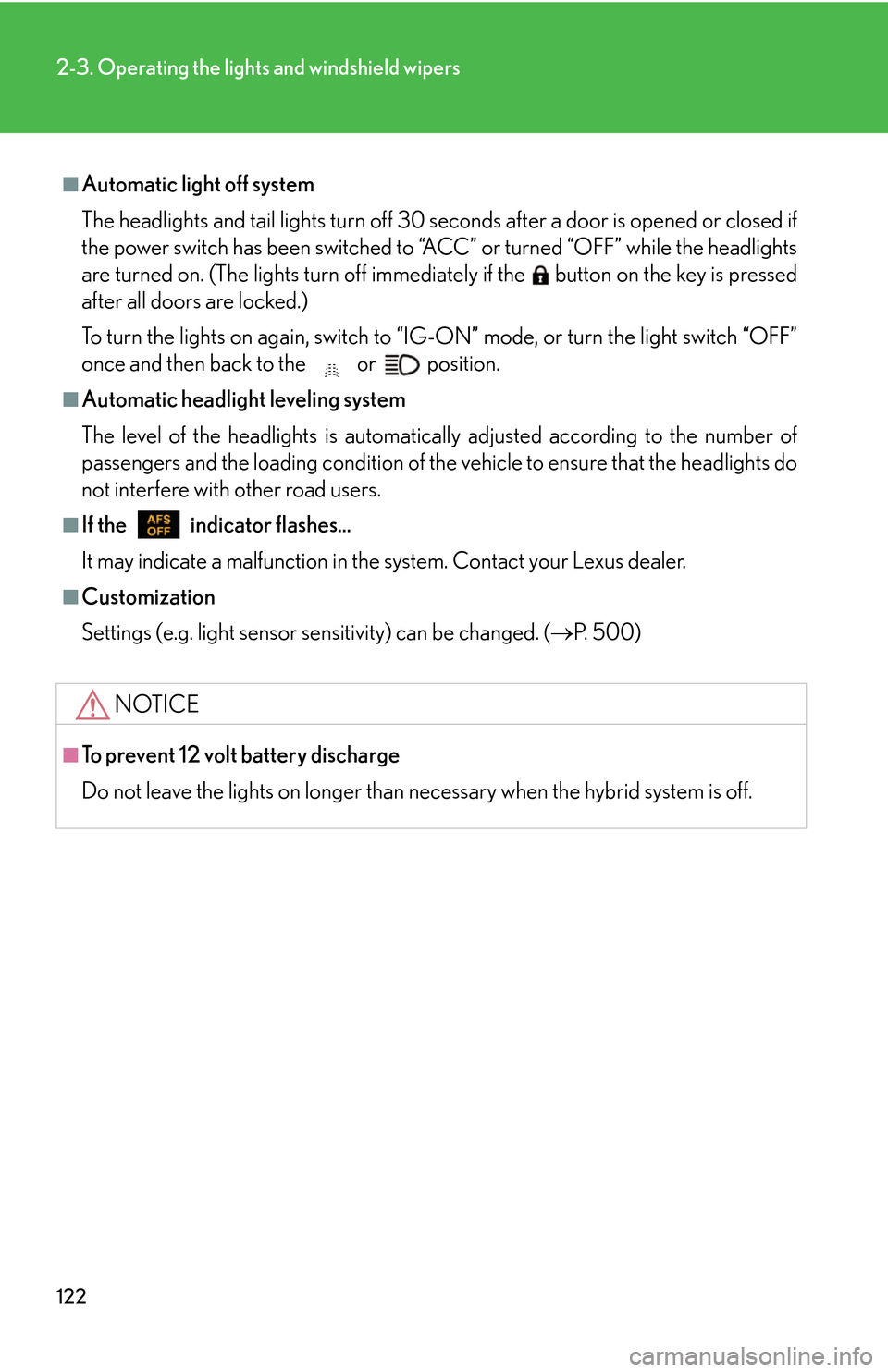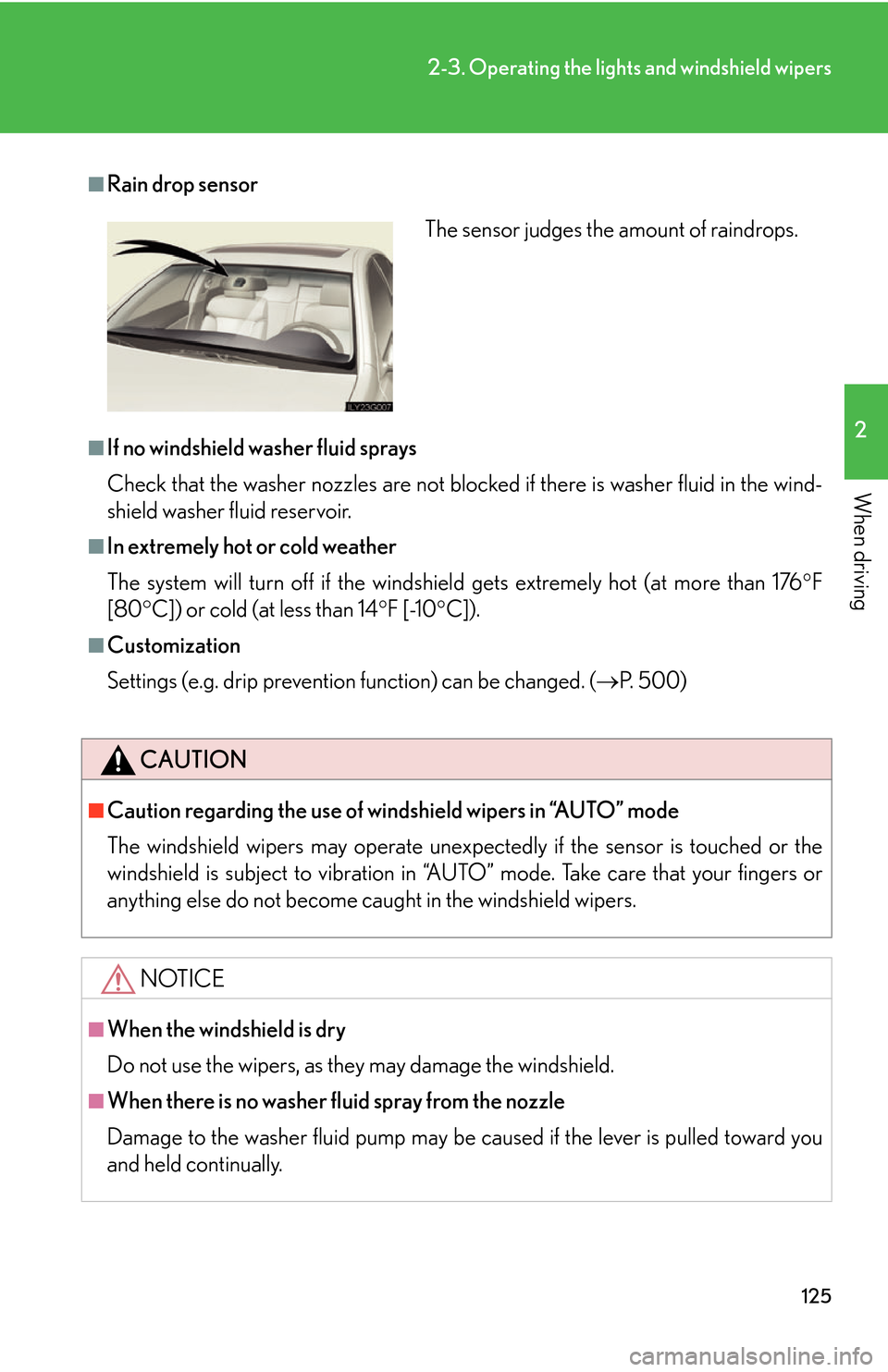sensor Lexus GS450h 2007 Using the audio system / LEXUS 2007 GS450H THROUGH JUNE 2006 PROD. OWNER'S MANUAL (OM30727U)
[x] Cancel search | Manufacturer: LEXUS, Model Year: 2007, Model line: GS450h, Model: Lexus GS450h 2007Pages: 540, PDF Size: 17.11 MB
Page 26 of 540

6
1-1. Hybrid system
■Hybrid battery air vent
Hybrid battery air vent
There is an air intake vent on the
package tray for the purpose of
cooling the hybrid battery (trac-
tion battery). If the vent becomes
block
ed, the hybrid battery may
overheat, leading to a reduction in
hybrid battery output.
Emergency shut off system
The emergency shut off system blocks off the high voltage current and
stops the fuel pump to minimize the risk of el ectrocution and fuel leakage
when a certain level of impact is detected by the impact sensor. If the
emergency shut off system activates, yo ur vehicle will not restart. To
restart the hybrid system, contact your Lexus dealer.
Energy monitor/consumption screen
You can view the status of your h ybrid system on the multi-information
display ( P. 117) and the touch screen( P. 1 8 2 ). The following images
are examples only, and may vary slightly from actual conditions.
■ Ener
gy monitor
●Ho
w to display on the touch screen:
Press .
To u c h on the “Information” screen.
If the “Consumption” screen is displayed, touch .
●How to display on the multi-information display:
Push the button several times to select the energy moni -
tor display.
STEP1
STEP2
STEP1
Page 35 of 540

15
1-3. Opening, closing and locking the doors and trunk
1
Before driving
Locking and unlocking the doors
Press the lock button to lock the
door.
Grip the handle to unlock the
door
.
Make sure to touch the sensor on
the back of the handle.
The door cannot be unlocked for 3
seconds af
ter the door is locked.
Unlocking the trunk
Press the button to unlock the
trunk.
Page 64 of 540

44
1-4. Adjustable components
Pre-collision seat belts (front seats of vehicles with pre-collision system)
When the pre-collision sensor detects an obstacle and determines that a
collision is unavoidable, the seat belts lessen collision injury by retracting
the slack in the front seat belts befo re the collision, thus restraining the
driver and passenger at an earlier stage.
The seat belts will also operate in the event of sudden braking. ( P. 1 6 7 )
■Emergency locking retractor (ELR)
The retractor will lock the belt during a sudd e
n stop or on impact. It may also lock if
you lean forward too quickly. A slow, easy motion will allow the belt to extend, and
you can move around fully.
■Automatic locking retractor (ALR)
When a passenger's shoulder bel
t is completely extended and then retracted even
slightly, the belt is locked in that position and cannot be extended. This feature is
used to hold the child restraint system (CRS) firmly. To free the belt again, fully
retract the belt and then pull the belt out once more. ( P. 8 7 )
■Pregnant women
Obtain medical advice and wear the seat belt
in the proper way. ( P. 4 2 )
Women who are pregnant should position
the lap belt as low as possible over the hips in
the same manner as other occupants. Extend
the shoulder belt completely over the shoul-
der and position the belt across the chest.
Avoid belt contact over the rounding of the
abdominal area.
If the seat belt is not worn properly, not only a
pregnant woman, but also the fetus could suf-
fer death or serious injury as a result of sud-
den braking or a collision.
Page 69 of 540

49
1
1-4. Adjustable components
Before driving
Inside rear view mirror
■To prevent sensor error
CAUTION
■Caution while driving
Do not adjust the position of the mirror while driving.
Doing so may lead to mishandling of the vehicle and an accident, or resulting in
death or serious injury.
In the “AUTO” mode, sensors are used to detect the headlights of vehicles
behind and automatically re duces the reflected light.
Turns “AUTO” mode on/off
The indicator comes on when
“AUTO” mode is turned ON.
The anti-glare mirror default
mode is “
AUTO”. The anti-glare
mirror is automatically set to
“AUTO” whenever the power
switch is turned ON.
To ensure correct functioning of the sensors,
do not touch or cover the sensors.
Page 90 of 540

70
1-8. Safety information
Airbag system components
The main SRS airbag system components are shown above. The SRS air-
bag system is controlled by the airb ag sensor as
sembly. The airbag sen-
sor assembly consists of a safing sensor and an airbag sensor.
Occupant detection sensor
Front passenger’s seat belt
buckle switch
Knee airbag
Front passenger airbag
Curtain shield airbag
Front side airbag
Side and curtain shield airbag
sensor Curtain shield airbag sensor
SRS warning light
Rear side airbag (if equipped)
Driver airbag
Driver's seat belt buckle switch
Driver's seat position sensor
Airbag sensor assembly
Front airbag sensor
Curtain shield airbag
Can help protect primarily the head of fr
ont occupants and rear out-
board occupants.
Page 141 of 540

121
2-3. Operating the lights and windshield wipers
2
When driving
AFS (Adaptive Front lighting System)
AFS improves visibility at intersectio ns and on curves by automatically
adjusting the level of the headlights according to vehicle speed and the
degree of the tire angle that are controlled by steering input.
Operates at speeds of 6 mph (10 km/h) or higher.
■ Deactivating AFS
Press the switch to turn it OFF.
The indicator turns on when
the AFS is deactivated.
■Daytime running light system
To make your vehicle more visible to other drivers, the headlights turn on automati -
cally (at a reduced intensity) whenever the hy
brid system is started and the parking
brake is released. Daytime running lights are not designed for use at night.
■Headlight control sensor
The sensor may not function properly if an
object is placed on the sensor, or anything
that blocks the sensor is affixed to the wind-
shield.
Doing so interferes with the sensor detecting
the level of ambient light and may cause the
automatic headlight system to malfunction.
Page 142 of 540

122
2-3. Operating the lights and windshield wipers
■Automatic light off system
The headlights and tail lights turn off 30 seconds after a door is opened or closed if
the power switch has been switched to “ACC” or turned “OFF” while the headlights
are turned on. (The lights turn off immediately if the button on the key is pressed
after all doors are locked.)
To turn the lights on again, switch to “IG-ON” mode, or turn the light switch “OFF”
once and then back to the or position.
■Automatic headlight leveling system
The level of the headlights is automatica lly adjusted according to the number of
passengers and the loading condition of the vehicle to ensure that the headlights do
not interfere with other road users.
■If the indicator flashes...
It may indicate a malfunction in the system. Contact your Lexus dealer.
■Customization
Settings (e.g. light sensor sensitivity) can be changed. ( P. 5 0 0 )
NOTICE
■To prevent 12 volt battery discharge
Do not leave the lights on longer than necessary when the hybrid system is off.
Page 144 of 540

124
2-3. Operating the lights and windshield wipers
Windshield wipers and washer
■The windshield wiper and washer can be operated when
The power switch is in “IG-ON” mode.
■Dripping prevention wiper sweep
After washing and wiping operation several times, the wipers operate one more
time af
ter a short delay to prevent dripping.
However, the last sweep will not happen if the vehicle is traveling above 106 mph
(1
70 km/h).
■Effects of vehicle speed on wiper operation
With the settings other than “AUTO” also, the time until drip prevention wiper
s
weep occurs is changed depending on vehicle speed.
With “LO” selected, wiper operation will be switched from low speed to intermit -
tent wiper operation only when the vehicle is stationary.
■ Rain-sensing windshield wipers
With “AUTO” selected, the wipers will operate automatically when
the sensor detects falling rain. The system automatically adjusts
wiper timing in accordance with rain volume and vehicle speed.
Sensor sensitivity (low)
Sensor sensitivity (high)
Rain-sensing wiper operation
Low speed wiper operation
High speed wiper operation
Temporary operation
Wash/wipe operation
Page 145 of 540

125
2-3. Operating the lights and windshield wipers
2
When driving
■Rain drop sensor
■If no windshield washer fluid sprays
Check that the washer nozzles are not blocked if there is washer fluid in the wind-
shield washer fluid reservoir.
■In extremely hot or cold weather
The system will turn off if the windshield gets extremely hot (at more than 176 F
[80 C]) or cold (at less than 14 F [-10C]).
■Customization
Settings (e.g. drip prevention function) can be changed. ( P. 500)
CAUTION
■Caution regarding the use of windshield wipers in “AUTO” mode
The windshield wipers may operate unexpectedly if the sensor is touched or the
windshield is subject to vibration in “AUT O” mode. Take care that your fingers or
anything else do not become caught in the windshield wipers.
NOTICE
■When the windshield is dry
Do not use the wipers, as they may damage the windshield.
■When there is no washer fluid spray from the nozzle
Damage to the washer fluid pump may be caused if the lever is pulled toward you
and held continually.
The sensor judges the amount of raindrops.
Page 153 of 540

133
2-4. Using other driving systems
2
When driving
Cruising in vehicle-to-vehicle distance control mode
This mode employs a radar sensor to detect the presence of vehicles
within 400 ft. (120 m) ahead and to judge the distance between your
vehicle and those vehicles.
Note that vehicle-to-vehicle distance will close when traveling on long down -
hill slopes.
Example of constant speed cruising (when there are no vehicles
ahead): When set to 62 mph (100 km/h)
The vehicle travels at the speed set by the driver. The desired vehicle-to-vehi-
cle distance can also be set by operating the vehicle-to-vehicle distance
swi
tch.
Example of deceleration cruising (wh en the vehicle ahead is driving
slower than the set speed): When fixed speed cruising is set at 6
2 mph
(100 km/h) and the vehicle ahead is driving at 50 mph (80 km/h)
When a vehicle is detected running ahead of you, in the same lane, the sys -
tem automatically decelerates your vehicle. When a greater reduction in
v
ehicle speed is necessary, the system applies the brakes. A warning tone
warns you on the system cannot decelerate sufficiently to prevent your vehi -
cle from closing on the vehicle ahead.